Birds are unusually common in the Yuba-Sutter area. In fact, Butte Sink Wildlife Management Area has the highest concentration of waterfowl per acre in the world, with typical wintering populations of more than 300,000 ducks and 100,000 geese.1 About 60% of the waterfowl population in the Pacific Flyway and 20% of the waterfowl population in North America spend the winter in California's Central Valley.2 This makes our area extremely popular for bird watching.
Some of the birds now common in our area were introduced by European immigrants, such as the common pheasant, Eurasian collared dove, Eurasian wigeon, European starling, greylag goose, house sparrow, Indian peafowl, rock pigeon, and wild turkey. However, the bird species listed below are native to the Yuba-Sutter area, having lived here long before the arrival of Europeans. This page provides information about how to identify our native birds by appearance and by sound, how to attract them to your yard with plants or bird feeders, and how to choose or build a birdhouse that will encourage them to nest in your yard.
Charadriiformes Order
Charadriiformes is a diverse order of birds, most of which live near water and eat invertebrates or other small animals.
Woodcock Family
- dunlin: pictures | video | sound (winter only; all of Sutter County and some of western Yuba County per California Department of Fish and Game: California Wildlife Habitat Relationships System: Life History Accounts and Range Maps)
- least sandpiper: pictures | video | sound (winter only; all of Sutter County and most of Yuba County per California Department of Fish and Game: California Wildlife Habitat Relationships System: Life History Accounts and Range Maps)
- Wilson's snipe: pictures | video | sound (winter in all of Yuba and Sutter Counties; yearlong in some portions of Yuba County per California Department of Fish and Game: California Wildlife Habitat Relationships System: Life History Accounts and Range Maps)
- long-billed dowitcher: pictures | video | sound (winter only; all of Sutter County and some of western Yuba County per California Department of Fish and Game: California Wildlife Habitat Relationships System: Life History Accounts and Range Maps)
- long-billed curlew: pictures | video | sound (winter only; all of Sutter County and the western half of Yuba County per California Department of Fish and Game: California Wildlife Habitat Relationships System: Life History Accounts and Range Maps)
- greater yellowlegs: pictures | video | sound (winter only; all of Sutter County and some of western Yuba County per California Department of Fish and Game: California Wildlife Habitat Relationships System: Life History Accounts and Range Maps)
Other Families
- killdeer: pictures | video | sound (year-round in most of Yuba and Sutter Counties; summer only in the remainder of Yuba County per California Department of Fish and Game: California Wildlife Habitat Relationships System: Life History Accounts and Range Maps; more information available from National Geographic)
- black tern: pictures | video | sound (summer only; all of Sutter County and some of western Yuba County per California Department of Fish and Game: California Wildlife Habitat Relationships System: Life History Accounts and Range Maps)
- black-necked stilt: pictures | video | sound (summer only; all of Sutter County and some of western Yuba County per California Department of Fish and Game: California Wildlife Habitat Relationships System: Life History Accounts and Range Maps)
- herring gull: pictures | video | sound (winter only; all of Sutter County and most of Yuba County per California Department of Fish and Game: California Wildlife Habitat Relationships System: Life History Accounts and Range Maps; more information available from National Geographic)
- California gull: pictures | video | sound (year-round; all of Sutter County and the western half of Yuba County per California Department of Fish and Game: California Wildlife Habitat Relationships System: Life History Accounts and Range Maps; more information available from National Geographic)
- ring-billed gull: pictures | video | sound (year-round; all of Sutter County and the western half of Yuba County per California Department of Fish and Game: California Wildlife Habitat Relationships System: Life History Accounts and Range Maps; more information available from National Geographic)
- American avocet: pictures | video | sound (year-round; all of Sutter County and some of western Yuba County per California Department of Fish and Game: California Wildlife Habitat Relationships System: Life History Accounts and Range Maps)
Ciconiiformes Order
Ciconiiformes is an order of large, long-legged wading birds with large bills: egrets, herons, ibises, spoonbills, storks, and several others.
Heron Family
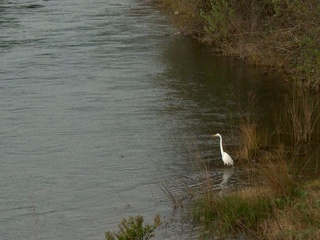 Great egrets (Ardea alba) are found year-round in all areas of Sutter County and all areas below approximately 250 feet in Yuba County—in other words, below Browns Valley. During the winter, they temporarily extend their range in Yuba County up to approximately 2,000 feet—as high as Dobbins. This great egret is shown wading in the American River. Photo by queerbychoice.
Great egrets (Ardea alba) are found year-round in all areas of Sutter County and all areas below approximately 250 feet in Yuba County—in other words, below Browns Valley. During the winter, they temporarily extend their range in Yuba County up to approximately 2,000 feet—as high as Dobbins. This great egret is shown wading in the American River. Photo by queerbychoice.
- great egret: pictures | video | sound (year-round in all of Sutter County and some of western Yuba County; winter only in some other parts of Yuba County per California Department of Fish and Game: California Wildlife Habitat Relationships System: Life History Accounts and Range Maps)
- great blue heron: pictures | video | sound (year-round in all of Yuba and Sutter Counties per California Department of Fish and Game: California Wildlife Habitat Relationships System: Life History Accounts and Range Maps)
- American bittern: pictures | video | sound (year-round; all of Sutter County and most of Yuba County per California Department of Fish and Game: California Wildlife Habitat Relationships System: Life History Accounts and Range Maps)
- cattle egret: pictures | video | sound (winter only in the Sutter Buttes and most of Yuba County; year-round in the remainder of Sutter County per California Department of Fish and Game: California Wildlife Habitat Relationships System: Life History Accounts and Range Maps)
- green heron: pictures | video | sound (year-round in all of Sutter County and some of western Yuba County; summer only in some other parts of Yuba County per California Department of Fish and Game: California Wildlife Habitat Relationships System: Life History Accounts and Range Maps)
- snowy egret: pictures | video | sound (year-round in most of Sutter County and some of western Yuba County; winter only in the Sutter Buttes and some other parts of Yuba County per California Department of Fish and Game: California Wildlife Habitat Relationships System: Life History Accounts and Range Maps)
- least bittern: pictures | video | sound (summer only; western Sutter County per California Department of Fish and Game: California Wildlife Habitat Relationships System: Life History Accounts and Range Maps)
- black-crowned night heron: pictures | video | sound (year-round; all of Sutter County and some of western Yuba County per California Department of Fish and Game: California Wildlife Habitat Relationships System: Life History Accounts and Range Maps)
Ibis Family
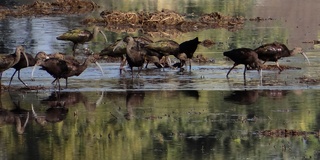 White-faced ibises (Plegadis chihi) are found year-round in northwestern Sutter County and in District Ten in Yuba County. These are shown in a flooded rice field in District Ten. Photo by queerbychoice.
White-faced ibises (Plegadis chihi) are found year-round in northwestern Sutter County and in District Ten in Yuba County. These are shown in a flooded rice field in District Ten. Photo by queerbychoice.
- white-faced ibis: pictures | video | sound (year-round; northwestern Sutter County only per California Department of Fish and Game: California Wildlife Habitat Relationships System: Life History Accounts and Range Maps)
Falconiformes Order
Falconiformes is an order of diurnal birds of prey.
Hawk Family
- Cooper's hawk: pictures | video | sound (year-round in all of Yuba and Sutter Counties per California Department of Fish and Game: California Wildlife Habitat Relationships System: Life History Accounts and Range Maps; more information available from National Geographic)
- sharp-shinned hawk: pictures | video | sound (winter only in all of Sutter County and most of Yuba County; year-round in far northeastern Yuba County per California Department of Fish and Game: California Wildlife Habitat Relationships System: Life History Accounts and Range Maps; more information available from National Geographic)
- golden eagle: pictures | video | sound (winter only in all of Sutter County and some of western Yuba County; year-round in the remainder of Yuba County per California Department of Fish and Game: California Wildlife Habitat Relationships System: Life History Accounts and Range Maps)
- red-tailed hawk: pictures | video | sound (year-round in all of Yuba and Sutter Counties per California Department of Fish and Game: California Wildlife Habitat Relationships System: Life History Accounts and Range Maps; prefers to nest on a 24" x 24" platform with no walls per U.S. Fish & Wildlife Service Migratory Bird Program; more information available from National Geographic)
- red-shouldered hawk: pictures | video | sound (year-round; all of Sutter County and most of Yuba County per California Department of Fish and Game: California Wildlife Habitat Relationships System: Life History Accounts and Range Maps; prefers to nest on a 24" x 24" platform with no walls per U.S. Fish & Wildlife Service Migratory Bird Program)
- ferruginous hawk: pictures | video | sound (winter only; all of Sutter County and some of western Yuba County per California Department of Fish and Game: California Wildlife Habitat Relationships System: Life History Accounts and Range Maps)
- Swainson's hawk: pictures | video | sound (summer only; most of Sutter County and some of western Yuba County per California Department of Fish and Game: California Wildlife Habitat Relationships System: Life History Accounts and Range Maps)
- northern harrier: pictures | video | sound (year-round in all of Sutter County and some of western Yuba County; winter only in some other parts of Yuba County per California Department of Fish and Game: California Wildlife Habitat Relationships System: Life History Accounts and Range Maps)
- white-tailed kite: pictures | video | sound (year-round; all of Sutter County and most of Yuba County per California Department of Fish and Game: California Wildlife Habitat Relationships System: Life History Accounts and Range Maps)
- bald eagle: pictures | video | sound (winter only in all of Sutter County and some of western Yuba County; year-round in the remainder of Yuba County per California Department of Fish and Game: California Wildlife Habitat Relationships System: Life History Accounts and Range Maps)
Other Families
 Turkey vultures (Cathartes aura) are found year-round in all areas of Sutter County and all areas below approximately 2,000 feet in Yuba County—in other words, from approximately Dobbins downward. During the summer, they temporarily extend their range to encompass all of both counties. This turkey vulture is shown flying above Sicard Flat. Photo by queerbychoice.
Turkey vultures (Cathartes aura) are found year-round in all areas of Sutter County and all areas below approximately 2,000 feet in Yuba County—in other words, from approximately Dobbins downward. During the summer, they temporarily extend their range to encompass all of both counties. This turkey vulture is shown flying above Sicard Flat. Photo by queerbychoice.
- turkey vulture: pictures | video | sound (year-round in all of Sutter County and most of Yuba County; summer only in the remainder of Yuba County per California Department of Fish and Game: California Wildlife Habitat Relationships System: Life History Accounts and Range Maps; more information available from National Geographic)
- merlin: pictures | video | sound (winter only; all of Yuba and Sutter Counties per California Department of Fish and Game: California Wildlife Habitat Relationships System: Life History Accounts and Range Maps)
- prairie falcon: pictures | video | sound (winter only; all of Sutter County and most of Yuba County per California Department of Fish and Game: California Wildlife Habitat Relationships System: Life History Accounts and Range Maps)
- American kestrel: pictures | video | sound (year-round in all of Yuba and Sutter Counties per California Department of Fish and Game: California Wildlife Habitat Relationships System: Life History Accounts and Range Maps; prefers a birdhouse located ten to thirty feet off the ground with 8" x 8" floor, 12" to 15" high ceiling, and entrance hole 3" in diameter placed 9" to 12" above the floor per U.S. Fish & Wildlife Service Migratory Bird Program; more information available from National Geographic)
Gruiformes Order
Gruiformes is a diverse order of wading and terrestrial birds, including cranes, crakes, rails, and other birds believed to be related to these.
Crane Family
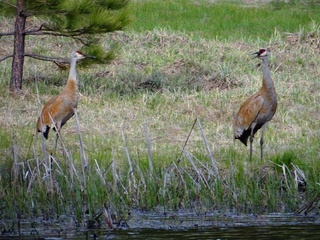 Sandhill cranes (Grus canadensis) are found in winter only in all areas of Sutter County and all areas below approximately 100 feet in Yuba County—in other words, from approximately the Trainer Hills downward. These sandhill cranes are shown on the shores of Snake Lake in Plumas County. Photo by queerbychoice.
Sandhill cranes (Grus canadensis) are found in winter only in all areas of Sutter County and all areas below approximately 100 feet in Yuba County—in other words, from approximately the Trainer Hills downward. These sandhill cranes are shown on the shores of Snake Lake in Plumas County. Photo by queerbychoice.
- sandhill crane: pictures | video | sound (winter only; all of Sutter County and some of western Yuba County per California Department of Fish and Game: California Wildlife Habitat Relationships System: Life History Accounts and Range Maps)
Rail Family
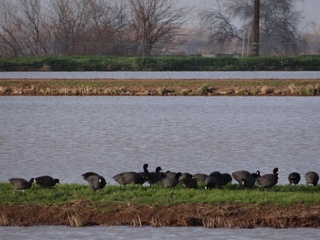 American coots (Fulica americana) in District 10, January 2017. Photo by queerbychoice.
American coots (Fulica americana) in District 10, January 2017. Photo by queerbychoice.
- American coot: pictures | video | sound (year-round in all of Sutter County and most of Yuba County; winter only in the remainder of Yuba County per California Department of Fish and Game: California Wildlife Habitat Relationships System: Life History Accounts and Range Maps)
- common moorhen: pictures | video | sound (year-round; all of Sutter County and most of Yuba County; winter only in the remainder of Yuba County per California Department of Fish and Game: California Wildlife Habitat Relationships System: Life History Accounts and Range Maps)
Passeriformes Order
Passeriformes is an order that includes more than half of all bird species and is one of the most diverse terrestrial vertebrate orders. It is sometimes known as the order of perching birds.
Bunting Family
 Dark-eyed juncos (Junco hyemalis) are found in winter only in all of Sutter County and all areas below approximately 2,000 feet in Yuba County (in other words, below Bullards Bar Reservoir) and year-round from there to approximately 4,000 feet in Yuba County (in other words, up to North Star); they are found in summer only in the remainder of Yuba County. This dark-eyed junco, seen in a garden in Marysville, is a male of the Oregon race. Photo by queerbychoice.
Dark-eyed juncos (Junco hyemalis) are found in winter only in all of Sutter County and all areas below approximately 2,000 feet in Yuba County (in other words, below Bullards Bar Reservoir) and year-round from there to approximately 4,000 feet in Yuba County (in other words, up to North Star); they are found in summer only in the remainder of Yuba County. This dark-eyed junco, seen in a garden in Marysville, is a male of the Oregon race. Photo by queerbychoice.
- rufous-crowned sparrow: pictures | video | sound (year-round; Sutter Buttes and central Yuba County per California Department of Fish and Game: California Wildlife Habitat Relationships System: Life History Accounts and Range Maps; found in central oak woodland per Las Pilitas Nursery; likes oaks and chamise per Las Pilitas Nursery)
- grasshopper sparrow: pictures | video | sound (summer only; all of Sutter County and most of Yuba County per California Department of Fish and Game: California Wildlife Habitat Relationships System: Life History Accounts and Range Maps)
- lark sparrow: pictures | video | sound (year-round; all of Sutter County and the western half of Yuba County per California Department of Fish and Game: California Wildlife Habitat Relationships System: Life History Accounts and Range Maps; found in central oak woodland and riparian forest per Las Pilitas Nursery; more information available from National Geographic)
- dark-eyed junco: pictures | video | sound (winter only in all of Sutter County and most of Yuba County; summer only in far northeastern Yuba County; year-round in the remainder of Yuba County per California Department of Fish and Game: California Wildlife Habitat Relationships System: Life History Accounts and Range Maps; found in yellow pine forest per Las Pilitas Nursery; eats black oil sunflower seeds, hulled sunflower seeds, cracked corn, millet, milo, nyjer, oats, peanut hearts, and safflower from ground, large hopper, and platform bird feeders per Project FeederWatch: Common Feeder Birds; more information available from National Geographic)
- Lincoln's sparrow: pictures | video | sound (winter only in all of Sutter County and most of Yuba County; summer only in the remainder of Yuba County per California Department of Fish and Game: California Wildlife Habitat Relationships System: Life History Accounts and Range Maps)
- song sparrow: pictures | video | sound (year-round in all of Sutter County and most of Yuba County; summer only in some of eastern Yuba County per California Department of Fish and Game: California Wildlife Habitat Relationships System: Life History Accounts and Range Maps; found in riparian forest per Las Pilitas Nursery; eats black oil sunflower seeds, hulled sunflower seeds, cracked corn, millet, milo, nyjer, peanut hearts, and safflower from ground and platform bird feeders per Project FeederWatch: Common Feeder Birds; more information available from National Geographic)
- savannah sparrow: pictures | video | sound (winter only; all of Sutter County and most of Yuba County per California Department of Fish and Game: California Wildlife Habitat Relationships System: Life History Accounts and Range Maps; found in valley grassland per Las Pilitas Nursery; likes pickleweed per Las Pilitas Nursery)
- fox sparrow: pictures | video | sound (winter only in all of Sutter County and most of Yuba County; summer only in far northeastern Yuba County; year-round in the remainder Yuba County per California Department of Fish and Game: California Wildlife Habitat Relationships System: Life History Accounts and Range Maps; found in riparian forest per Las Pilitas Nursery; eats black oil sunflower seeds, hulled sunflower seeds, cracked corn, millet, milo, and nyjer from ground and platform bird feeders per Project FeederWatch: Common Feeder Birds; more information available from National Geographic)
- California towhee: pictures | video | sound (year-round; all of Sutter County and most of Yuba County per California Department of Fish and Game: California Wildlife Habitat Relationships System: Life History Accounts and Range Maps; eats black oil sunflower seeds, hulled sunflower seeds, cracked corn, millet, milo, and peanut hearts from ground and platform bird feeders per Project FeederWatch: Common Feeder Birds; more information available from National Geographic)
- spotted towhee: pictures | video | sound (year-round in all of Sutter County and most of Yuba County; summer only in some of eastern Yuba County per California Department of Fish and Game: California Wildlife Habitat Relationships System: Life History Accounts and Range Maps; found in central oak woodland and riparian forest per Las Pilitas Nursery; eats black oil sunflower seeds, hulled sunflower seeds, cracked corn, millet, milo, and peanut hearts from ground and platform bird feeders per Project FeederWatch: Common Feeder Birds; more information available from National Geographic)
- chipping sparrow: pictures | video | sound (winter only in all of Sutter County and the western half of Yuba County; summer only in the eastern half of Yuba County per California Department of Fish and Game: California Wildlife Habitat Relationships System: Life History Accounts and Range Maps; found in central oak woodland per Las Pilitas Nursery; eats hulled sunflower seeds, cracked corn, millet, milo, and nyjer from ground, large and small hopper, and platform bird feeders per Project FeederWatch: Common Feeder Birds; more information available from National Geographic)
- golden-crowned sparrow: pictures | video | sound (winter only; all of Sutter County and most of Yuba County per California Department of Fish and Game: California Wildlife Habitat Relationships System: Life History Accounts and Range Maps; more information available from Las Pilitas Nursery; eats black oil sunflower seeds, hulled sunflower seeds, cracked corn, millet, milo, peanut hearts, and safflower from ground and platform bird feeders per Project FeederWatch: Common Feeder Birds; more information available from National Geographic)
- white-crowned sparrow: pictures | video | sound (winter only; all of Sutter County and most of Yuba County per California Department of Fish and Game: California Wildlife Habitat Relationships System: Life History Accounts and Range Maps; found in riparian forest per Las Pilitas Nursery; likes willows per Las Pilitas Nursery; eats black oil sunflower seeds, hulled sunflower seeds, cracked corn, millet, and milo from ground and platform bird feeders per Project FeederWatch: Common Feeder Birds; more information available from National Geographic)
- Harris's sparrow: pictures | video | sound (winter only; all of Sutter County except the Sutter Buttes and all of Yuba County except the farthest northeastern tip per California Department of Fish and Game: California Wildlife Habitat Relationships System: Life History Accounts and Range Maps; eats black oil sunflower seeds, hulled sunflower seeds, cracked corn, and millet from ground and platform bird feeders per Project FeederWatch: Common Feeder Birds; more information available from National Geographic)
 White-crowned sparrows (Zonotrichia leucophrys) are found in winter only in all areas of Sutter County and all areas below approximately 2,800 feet in Yuba County—in other words, below Camptonville. This white-crowned sparrow is shown in a garden in Marysville. Photo by queerbychoice.
White-crowned sparrows (Zonotrichia leucophrys) are found in winter only in all areas of Sutter County and all areas below approximately 2,800 feet in Yuba County—in other words, below Camptonville. This white-crowned sparrow is shown in a garden in Marysville. Photo by queerbychoice.
Cardinal Family
- lazuli bunting: pictures | video | sound (summer only; all of Yuba and Sutter Counties per California Department of Fish and Game: California Wildlife Habitat Relationships System: Life History Accounts and Range Maps; more information available from Las Pilitas Nursery)
- black-headed grosbeak: pictures | video | sound (summer only; all of Yuba and Sutter Counties per California Department of Fish and Game: California Wildlife Habitat Relationships System: Life History Accounts and Range Maps; found in central oak woodland and riparian forest per Las Pilitas Nursery; eats cherries and elderberries per Las Pilitas Nursery; more information available from National Geographic)
- Western tanager: pictures | video | sound (summer only; northeastern Yuba County per California Department of Fish and Game: California Wildlife Habitat Relationships System: Life History Accounts and Range Maps; found in yellow pine forest per Las Pilitas Nursery; eats cherries and berries per Las Pilitas Nursery; more information available from National Geographic)
Crow Family
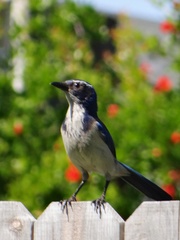 Western scrub-jays (Aphelocoma californica) are found year-round in all areas of Sutter County and all areas below approximately 2,000 feet in Yuba County—in other words, below Bullards Bar Reservoir. This Western scrub-jay is shown perching on a backyard fence in Marysville. Photo by queerbychoice.
Western scrub-jays (Aphelocoma californica) are found year-round in all areas of Sutter County and all areas below approximately 2,000 feet in Yuba County—in other words, below Bullards Bar Reservoir. This Western scrub-jay is shown perching on a backyard fence in Marysville. Photo by queerbychoice.
- Western scrub-jay: pictures | video | sound (year-round; all of Sutter County and most of Yuba County per California Department of Fish and Game: California Wildlife Habitat Relationships System: Life History Accounts and Range Maps; found in central oak woodland and riparian forest per Las Pilitas Nursery; eats acorns and toyon berries per Las Pilitas Nursery; eats black oil sunflower seeds, hulled sunflower seeds, cracked corn, fruit, mealworms, millet, milo, peanut hearts, peanuts, and suet from ground, large hopper, large tube, platform, and suet cage bird feeders per Project FeederWatch: Common Feeder Birds</a;>National Geographic
- American crow: pictures | video | sound (year-round in all of Sutter County and most of Yuba County; summer only in some of eastern Yuba County per California Department of Fish and Game: California Wildlife Habitat Relationships System: Life History Accounts and Range Maps; eats black oil sunflower seeds, hulled sunflower seeds, cracked corn, fruit, millet, milo, oats, peanut hearts, and peanuts from ground and platform bird feeders per Project FeederWatch: Common Feeder Birds; more information available from National Geographic)
- common raven: pictures | video | sound (year-round; northeastern Yuba County only per California Department of Fish and Game: California Wildlife Habitat Relationships System: Life History Accounts and Range Maps; eats black oil sunflower seeds, hulled sunflower seeds, cracked corn, peanut hearts, peanuts, and suet from ground and platform bird feeders per Project FeederWatch: Common Feeder Birds; more information available from National Geographic)
- Steller's jay: pictures | video | sound (year-round in northeastern Yuba County; winter only in some other parts of Yuba County per California Department of Fish and Game: California Wildlife Habitat Relationships System: Life History Accounts and Range Maps; more information available from National Geographic)
- yellow-billed magpie: pictures | video | sound (year-round; all of Sutter County and the western half of Yuba County per California Department of Fish and Game: California Wildlife Habitat Relationships System: Life History Accounts and Range Maps; found in central oak woodland per Las Pilitas Nursery; likes oaks per Las Pilitas Nursery)
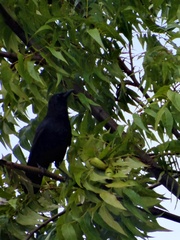 American crows (Corvus brachyrhynchos) are found year-round in all areas of Sutter County and all areas below approximately 2,000 feet in Yuba County—in other words, below Bullards Bar Reservoir; they are found in the remainder of Yuba County in the summer only. This American crow is shown perching in a tree in Marysville. Photo by queerbychoice.
American crows (Corvus brachyrhynchos) are found year-round in all areas of Sutter County and all areas below approximately 2,000 feet in Yuba County—in other words, below Bullards Bar Reservoir; they are found in the remainder of Yuba County in the summer only. This American crow is shown perching in a tree in Marysville. Photo by queerbychoice.
Finch Family
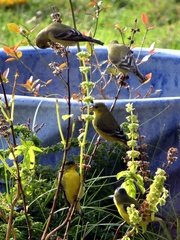 Lesser goldfinches (Spinus psaltria) are found year-round in all areas of Sutter County and all areas below approximately 1,300 feet in Yuba County—in other words, below Collins Lake. During the summer, they temporarily extend their range in Yuba County up to approximately 3,500 feet—a little below Strawberry Valley. Males have black "caps" on their heads and are a brighter yellow than females; the two birds at the bottom of this picture are identifiably male. These lesser goldfinches are shown eating basil seeds in a garden in Marysville. Photo by queerbychoice.
Lesser goldfinches (Spinus psaltria) are found year-round in all areas of Sutter County and all areas below approximately 1,300 feet in Yuba County—in other words, below Collins Lake. During the summer, they temporarily extend their range in Yuba County up to approximately 3,500 feet—a little below Strawberry Valley. Males have black "caps" on their heads and are a brighter yellow than females; the two birds at the bottom of this picture are identifiably male. These lesser goldfinches are shown eating basil seeds in a garden in Marysville. Photo by queerbychoice.
- pine siskin: pictures | video | sound (winter only in all of Sutter County and most of Yuba County; year round in the remainder of Yuba County per California Department of Fish and Game: California Wildlife Habitat Relationships System: Life History Accounts and Range Maps; eats black oil sunflower seeds, hulled sunflower seeds, and nyjer from ground, large and small hopper, large and small tube, and platform bird feeders per Project FeederWatch: Common Feeder Birds; more information available from National Geographic)
- lesser goldfinch: pictures | video | sound (year round in all of Sutter County and the western half of Yuba County; summer only in some of eastern Yuba County per California Department of Fish and Game: California Wildlife Habitat Relationships System: Life History Accounts and Range Maps; found in central oak woodland, valley grassland, and riparian forest per Las Pilitas Nursery; eats bits of oaks and willows per Las Pilitas Nursery; eats black oil sunflower seeds, hulled sunflower seeds, and nyjer from large and small hopper, large and small tube, and platform bird feeders per Project FeederWatch: Common Feeder Birds; more information available from National Geographic)
- Lawrence's goldfinch: pictures | video | sound (summer only; central Yuba County per California Department of Fish and Game: California Wildlife Habitat Relationships System: Life History Accounts and Range Maps; found in central oak woodland per Las Pilitas Nursery)
- American goldfinch: pictures | video | sound (year-round; all of Sutter County and most of Yuba County per California Department of Fish and Game: California Wildlife Habitat Relationships System: Life History Accounts and Range Maps; eats black oil sunflower seeds, hulled sunflower seeds, and nyjer from ground, large and small hopper, large and small tube, and platform bird feeders per Project FeederWatch: Common Feeder Birds; more information available from National Geographic)
- Cassin's finch: pictures | video | sound (summer only in some of eastern Yuba County; year-round in northeastern Yuba County per California Department of Fish and Game: California Wildlife Habitat Relationships System: Life History Accounts and Range Maps; eats black oil sunflower seeds, hulled sunflower seeds, and nyjer from large and small hopper, large and small tube, and platform bird feeders per Project FeederWatch: Common Feeder Birds; more information available from National Geographic)
- house finch: pictures | video | sound (year-round; all of Sutter County and most of Yuba County per California Department of Fish and Game: California Wildlife Habitat Relationships System: Life History Accounts and Range Maps; eats black oil sunflower seeds, hulled sunflower seeds, nyjer, and safflower from large and small hopper, large and small tube, and platform bird feeders per Project FeederWatch: Common Feeder Birds; more information available from National Geographic)
- purple finch: pictures | video | sound (year-round in northeastern Yuba County; winter only in central Yuba County per California Department of Fish and Game: California Wildlife Habitat Relationships System: Life History Accounts and Range Maps; more information available from Las Pilitas Nursery; eats black oil sunflower seeds, hulled sunflower seeds, millet, and nyjer from large and small hopper, large and small tube, and platform bird feeders per Project FeederWatch: Common Feeder Birds; more information available from National Geographic)
- red crossbill: pictures | video | sound (summer only; northeastern Yuba County per California Department of Fish and Game: California Wildlife Habitat Relationships System: Life History Accounts and Range Maps)
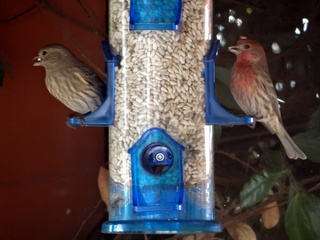 House finches (Haemorhous mexicanus) are found year-round in all areas of Sutter County and all areas below approximately 1,300 feet in Yuba County—in other words, below Collins Lake. This picture shows a male (with characteristic reddish coloring) and female house finch eating safflower seeds at a bird feeder in Marysville. Photo by queerbychoice.
House finches (Haemorhous mexicanus) are found year-round in all areas of Sutter County and all areas below approximately 1,300 feet in Yuba County—in other words, below Collins Lake. This picture shows a male (with characteristic reddish coloring) and female house finch eating safflower seeds at a bird feeder in Marysville. Photo by queerbychoice.
Flycatcher Family
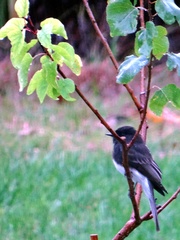 Black phoebes (Sayornis nigricans) are found year-round in all of Sutter County and all areas below approximately 4,000 feet in Yuba County—in other words, below North Star. This black phoebe is shown in a garden in Marysville. Photo by queerbychoice.
Black phoebes (Sayornis nigricans) are found year-round in all of Sutter County and all areas below approximately 4,000 feet in Yuba County—in other words, below North Star. This black phoebe is shown in a garden in Marysville. Photo by queerbychoice.
- olive-sided flycatcher: pictures | video | sound (summer only; northeastern Yuba County per California Department of Fish and Game: California Wildlife Habitat Relationships System: Life History Accounts and Range Maps; found in yellow pine forest and riparian forest per Las Pilitas Nursery; eats primarily honeybees per Las Pilitas Nursery)
- Western wood-pewee: pictures | video | sound (summer only; most of Yuba County per California Department of Fish and Game: California Wildlife Habitat Relationships System: Life History Accounts and Range Maps; found in central oak woodland, yellow pine forest, and riparian forest per Las Pilitas Nursery; eats elderberries per Las Pilitas Nursery; more information available from National Geographic)
- Hammond's flycatcher: pictures | video | sound (summer only; northeastern Yuba County per California Department of Fish and Game: California Wildlife Habitat Relationships System: Life History Accounts and Range Maps; more information available from Las Pilitas Nursery)
- dusky flycatcher: pictures | video | sound (year-round; eastern half of Yuba County per California Department of Fish and Game: California Wildlife Habitat Relationships System: Life History Accounts and Range Maps)
- ash-throated flycatcher: pictures | video | sound (summer only; all of Sutter County and most of Yuba County per California Department of Fish and Game: California Wildlife Habitat Relationships System: Life History Accounts and Range Maps; found in central oak woodland and riparian forest per Las Pilitas Nursery; prefers a birdhouse located in a tree five to fifteen feet off the ground with 6" x 6" floor, 8" to 12" high ceiling, and entrance hole 1.5" in diameter placed 6" to 10" above the floor per U.S. Fish & Wildlife Service Migratory Bird Program; more information available from National Geographic)
- black phoebe: pictures | video | sound (year-round; all of Sutter County and most of Yuba County per California Department of Fish and Game: California Wildlife Habitat Relationships System: Life History Accounts and Range Maps; found in valley grassland and riparian forest per Las Pilitas Nursery; likes Frémont's cottonwoods per Las Pilitas Nursery; prefers a nesting shelf located eight to twelve feet off the ground with 6" x 6" floor, 6" high ceiling, and and just three walls plus a completely open front per U.S. Fish & Wildlife Service Migratory Bird Program; more information available from National Geographic)
- Say's phoebe: pictures | video | sound (winter only; all of Sutter County and most of Yuba County per California Department of Fish and Game: California Wildlife Habitat Relationships System: Life History Accounts and Range Maps; found in valley grassland, , and riparian forest per Las Pilitas Nursery; eats primarily insects and occasionally elderberries per Las Pilitas Nursery; more information available from National Geographic)
- Western kingbird: pictures | video | sound (summer only; all of Sutter County and most of Yuba County per California Department of Fish and Game: California Wildlife Habitat Relationships System: Life History Accounts and Range Maps; found in valley grassland per Las Pilitas Nursery; more information available from National Geographic)
Oriole Family
- red-winged blackbird: pictures | video | sound (year-round in all of Sutter County and most of Yuba County; summer only in the remainder of Yuba County per California Department of Fish and Game: California Wildlife Habitat Relationships System: Life History Accounts and Range Maps; eats black oil sunflower seeds, hulled sunflower seeds, cracked corn, millet, milo, oats, and peanut hearts from ground, large hopper, large tube, and platform bird feeders per Project FeederWatch: Common Feeder Birds; more information available from National Geographic)
- tricolored blackbird: pictures | video | sound (year-round; all of Sutter County and most of Yuba County per California Department of Fish and Game: California Wildlife Habitat Relationships System: Life History Accounts and Range Maps)
- Brewer's blackbird: pictures | video | sound (year-round in all of Sutter County and most of Yuba County; summer only in the remainder of Yuba County per California Department of Fish and Game: California Wildlife Habitat Relationships System: Life History Accounts and Range Maps; found in valley grassland and riparian forest per Las Pilitas Nursery; eats hulled sunflower seeds, cracked corn, and millet from ground and platform bird feeders per Project FeederWatch: Common Feeder Birds; more information available from National Geographic)
- Bullock's oriole: pictures | video | sound (summer only; all of Sutter County and most of Yuba County per California Department of Fish and Game: California Wildlife Habitat Relationships System: Life History Accounts and Range Maps; more information available from National Geographic)
- hooded oriole: pictures | video | sound (summer only; all of Sutter County and some of western Yuba County per California Department of Fish and Game: California Wildlife Habitat Relationships System: Life History Accounts and Range Maps; found in central oak woodland and riparian forest per Las Pilitas Nursery; more information available from National Geographic)
- brown-headed cowbird: pictures | video | sound (year-round in all of Sutter County and most of Yuba County; summer only in the remainder of Yuba County per California Department of Fish and Game: California Wildlife Habitat Relationships System: Life History Accounts and Range Maps; more information available from National Geographic)
- Western meadowlark: pictures | video | sound (year-round; all of Sutter County and most of Yuba County per California Department of Fish and Game: California Wildlife Habitat Relationships System: Life History Accounts and Range Maps; eats hulled sunflower seeds and cracked corn from ground bird feeders per Project FeederWatch: Common Feeder Birds; more information available from National Geographic)
- yellow-headed blackbird: pictures | video | sound (year-round in most of Sutter County and some of western Yuba County; summer only in the remainder of Sutter County and most of western Yuba County per California Department of Fish and Game: California Wildlife Habitat Relationships System: Life History Accounts and Range Maps)
Mockingbird Family
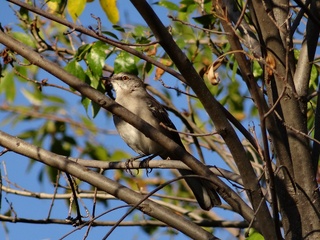 Northern mockingbirds (Mimus polyglottos) are found year-round in all areas of Sutter County and all areas below approximately 500 feet in Yuba County—in other words, as high as Loma Rica. This Northern mockingbird is perched in a tree in Marysville. Photo by queerbychoice.
Northern mockingbirds (Mimus polyglottos) are found year-round in all areas of Sutter County and all areas below approximately 500 feet in Yuba County—in other words, as high as Loma Rica. This Northern mockingbird is perched in a tree in Marysville. Photo by queerbychoice.
- Northern mockingbird: pictures | video | sound (year-round; all of Sutter County and some of western Yuba County per California Department of Fish and Game: California Wildlife Habitat Relationships System: Life History Accounts and Range Maps; more information available from National Geographic)
- California thrasher: pictures | video | sound (year-round; eastern Sutter County and various parts of Yuba County per California Department of Fish and Game: California Wildlife Habitat Relationships System: Life History Accounts and Range Maps; found in central oak woodland and riparian forest per Las Pilitas Nursery; eats insects, spiders, invertebrates, and fruit per Las Pilitas Nursery)
Tit Family
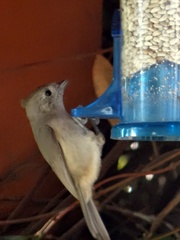 Oak titmice (Baeolophus inornatus) are found year-round in all areas of Sutter County and all areas below approximately 2,800 feet in Yuba County—in other words, below Camptonville. This oak titmouse is shown eating safflower seeds at a bird feeder in Marysville. Photo by queerbychoice.
Oak titmice (Baeolophus inornatus) are found year-round in all areas of Sutter County and all areas below approximately 2,800 feet in Yuba County—in other words, below Camptonville. This oak titmouse is shown eating safflower seeds at a bird feeder in Marysville. Photo by queerbychoice.
- oak titmouse: pictures | video | sound (year-round; all of Sutter County and most of Yuba County per California Department of Fish and Game: California Wildlife Habitat Relationships System: Life History Accounts and Range Maps; found in central oak woodland per Las Pilitas Nursery; likes oaks per Las Pilitas Nursery; eats black oil sunflower seeds, hulled sunflower seeds, mealworms, peanut hearts, peanuts, safflower, and suet from large and small hopper, large and small tube, platform, and suet cage bird feeders per Project FeederWatch: Common Feeder Birds); prefers a birdhouse located five to fifteen feet off the ground with 4" x 4" floor, 10" to 12" high ceiling, and entrance hole 1.25" in diameter placed 6" to 10" above the floor per U.S. Fish & Wildlife Service Migratory Bird Program; more information available from National Geographic)
- chestnut-backed chickadee: pictures | video | sound (year-round; northeastern Yuba County per California Department of Fish and Game: California Wildlife Habitat Relationships System: Life History Accounts and Range Maps; found in riparian forest per Las Pilitas Nursery; likes conifers per Las Pilitas Nursery; eats black oil sunflower seeds, hulled sunflower seeds, mealworms, nyjer, peanut hearts, peanuts, safflower, and suet from large and small hopper, large and small tube, platform, and suet cage bird feeders per Project FeederWatch: Common Feeder Birds; prefers a birdhouse hanging from a tree limb or secured to a tree trunk four to fifteen feet off the ground with 4" x 4" floor, 8" to 10" high ceiling, and entrance hole 1.125" in diameter placed 6" to 8" above the floor per U.S. Fish & Wildlife Service Migratory Bird Program; more information available from National Geographic)
Swallow Family
- cliff swallow: pictures | video | sound (summer only; all of Sutter County and most of Yuba County per California Department of Fish and Game: California Wildlife Habitat Relationships System: Life History Accounts and Range Maps; found in valley grassland and riparian forest per Las Pilitas Nursery; more information available from National Geographic)
- purple martin: pictures | video | sound (summer only; northeastern Yuba County per California Department of Fish and Game: California Wildlife Habitat Relationships System: Life History Accounts and Range Maps; prefers a birdhouse with about 40 feet of unobstructed flying space in all directions around it and porch railings or wires to perch on, located six to twenty feet off the ground, divided into a minimum of four large rooms with 6" x 6" floor in each room, 6" high ceiling, and entrance holes 2.25" to 2.5" in diameter placed 1" to 2" above the floor per U.S. Fish & Wildlife Service Migratory Bird Program; more information available from National Geographic)
- bank swallow: pictures | video | sound (summer only; Feather River and Sacramento River per California Department of Fish and Game: California Wildlife Habitat Relationships System: Life History Accounts and Range Maps)
- Northern rough-winged swallow: pictures | video | sound (summer only; all of Sutter County and most of Yuba County per California Department of Fish and Game: California Wildlife Habitat Relationships System: Life History Accounts and Range Maps; found in central oak woodland, valley grassland, and riparian forest per Las Pilitas Nursery)
- tree swallow: pictures | video | sound (year-round in all of Sutter County and the western half of Yuba County; summer only in the remainder of Yuba County per California Department of Fish and Game: California Wildlife Habitat Relationships System: Life History Accounts and Range Maps; prefers a birdhouse located in a large tree five to fifteen feet off the ground with 5" x 5" floor, 6" to 8" high ceiling, and entrance hole 1.5" in diameter placed 4" to 6" above the floor per U.S. Fish & Wildlife Service Migratory Bird Program; more information available from National Geographic)
- violet-green swallow: pictures | video | sound (year-round in all of Sutter County and some of western Yuba County; summer only in the remainder of Yuba County per California Department of Fish and Game: California Wildlife Habitat Relationships System: Life History Accounts and Range Maps; found in central oak woodland per Las Pilitas Nursery; prefers a birdhouse located in a large tree five to fifteen feet off the ground with 5" x 5" floor, 6" to 8" high ceiling, and entrance hole 1.5" in diameter placed 4" to 6" above the floor per U.S. Fish & Wildlife Service Migratory Bird Program; more information available from National Geographic)
Thrush Family
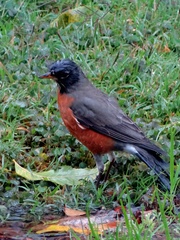 American robins (Turdus migratorius) are found year-round in all areas of Yuba and Sutter Counties. This American robin, shown in a garden in Marysville, is a male; his sex is indicated by the fact that his head is a darker gray than his body. Photo by queerbychoice.
American robins (Turdus migratorius) are found year-round in all areas of Yuba and Sutter Counties. This American robin, shown in a garden in Marysville, is a male; his sex is indicated by the fact that his head is a darker gray than his body. Photo by queerbychoice.
- hermit thrush: pictures | video | sound (winter only in all of Sutter County and most of Yuba County; summer only in far northeastern Yuba County; year-round in the remainder of Yuba County per California Department of Fish and Game: California Wildlife Habitat Relationships System: Life History Accounts and Range Maps; found in yellow pine forest per Las Pilitas Nursery; eats cherries and toyon berries per Las Pilitas Nursery; eats fruit, mealworms, and peanut hearts from ground and platform bird feeders per Project FeederWatch: Common Feeder Birds; more information available from National Geographic)
- Swainson's thrush: pictures | video | sound (summer only; northeastern Yuba County per California Department of Fish and Game: California Wildlife Habitat Relationships System: Life History Accounts and Range Maps; more information available from National Geographic)
- Townsend's solitaire: pictures | video | sound (winter only in central Yuba County; year-round in northeastern Yuba County per California Department of Fish and Game: California Wildlife Habitat Relationships System: Life History Accounts and Range Maps)
- Western bluebird: pictures | video | sound (winter only in all of Sutter County and some of western Yuba County; summer only in far northeastern Yuba County; year-round in the remainder of Yuba County per California Department of Fish and Game: California Wildlife Habitat Relationships System: Life History Accounts and Range Maps; found in central oak woodland and riparian forest per Las Pilitas Nursery; eats redberries, barberries, cherries, elderberries, grapes, and toyon berries per Las Pilitas Nursery; prefers to nest on a tall tree stump or in a birdhouse located on a fence post four to six feet off the ground with 5" x 5" floor, 8" to 12" high ceiling, and entrance hole 1.5" in diameter placed 6" to 10" above the floor per U.S. Fish & Wildlife Service Migratory Bird Program; more information available from National Geographic)
- American robin: pictures | video | sound (year-round in all of Yuba and Sutter Counties per California Department of Fish and Game: California Wildlife Habitat Relationships System: Life History Accounts and Range Maps; found in central oak woodland per Las Pilitas Nursery; eats toyon berries and juniper berries per Las Pilitas Nursery; eats hulled sunflower seeds, fruit, mealworms, peanut hearts, and suet from ground and platform bird feeders per Project FeederWatch: Common Feeder Birds; prefers to nest in the crotch of a tree or in a birdhouse six to fifteen feet off the ground with 7" x 8" floor per U.S. Fish & Wildlife Service Migratory Bird Program; more information available from National Geographic)
Vireo Family
- warbling vireo: pictures | video | sound (summer only; eastern half of Yuba County per California Department of Fish and Game: California Wildlife Habitat Relationships System: Life History Accounts and Range Maps; more information available from National Geographic)
- Hutton's vireo: pictures | video | sound (winter only in all of Sutter County and some of western Yuba County; year-round in some of central Yuba County per California Department of Fish and Game: California Wildlife Habitat Relationships System: Life History Accounts and Range Maps)
Warbler Family
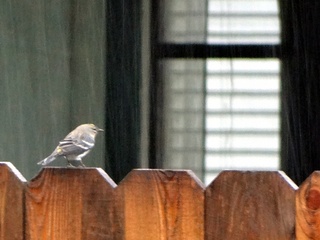 Yellow-rumped warblers (Setophaga coronata) are found in winter only in all of Sutter County and all areas below approximately 2,000 feet in Yuba County—in other words, below Bullards Bar Reservoir—and in summer only in the remainder of Yuba County. This yellow-rumped warbler is a female of the Audubon's race, seen in a garden in Marysville. The Audubon's race is distinguished from the Myrtle race by the absence of a white stripe through the eye and the presence (in adults) of a yellow spot on the throat. Photo by queerbychoice.
Yellow-rumped warblers (Setophaga coronata) are found in winter only in all of Sutter County and all areas below approximately 2,000 feet in Yuba County—in other words, below Bullards Bar Reservoir—and in summer only in the remainder of Yuba County. This yellow-rumped warbler is a female of the Audubon's race, seen in a garden in Marysville. The Audubon's race is distinguished from the Myrtle race by the absence of a white stripe through the eye and the presence (in adults) of a yellow spot on the throat. Photo by queerbychoice.
- Wilson's warbler: pictures | video | sound (summer only; northeastern Yuba County per California Department of Fish and Game: California Wildlife Habitat Relationships System: Life History Accounts and Range Maps)
- MacGillivray's warbler: pictures | video | sound (summer only; northeastern Yuba County per California Department of Fish and Game: California Wildlife Habitat Relationships System: Life History Accounts and Range Maps)
- orange-crowned warbler: pictures | video | sound (winter only in all of Sutter County and some of western Yuba County; summer only in some of northeastern Yuba County; year-round in the remainder of Yuba County per California Department of Fish and Game: California Wildlife Habitat Relationships System: Life History Accounts and Range Maps; likes manzanitas and California lilacs per Las Pilitas Nursery; more information available from National Geographic)
- Nashville warbler: pictures | video | sound (summer only; the eastern half of Yuba County per California Department of Fish and Game: California Wildlife Habitat Relationships System: Life History Accounts and Range Maps)
- yellow-rumped warbler: pictures | video | sound (winter only in all of Sutter County and most of Yuba County; summer only in the remainder of Yuba County per California Department of Fish and Game: California Wildlife Habitat Relationships System: Life History Accounts and Range Maps; eats fruit, hulled sunflower seeds, mealworms, peanut hearts, suet, and sugar water from large and small hopper, large and small tube, nectar, platform, and suet cage bird feeders per Project FeederWatch: Common Feeder Birds; more information available from National Geographic)
- black-throated gray warbler: pictures | video | sound (winter only along the Sacramento River and Yuba River; summer only in northeastern Yuba County per California Department of Fish and Game: California Wildlife Habitat Relationships System: Life History Accounts and Range Maps)
- yellow warbler: pictures | video | sound (summer only; most of Yuba County per California Department of Fish and Game: California Wildlife Habitat Relationships System: Life History Accounts and Range Maps; photos from Las Pilitas Nursery)
- American redstart: pictures | video | sound (winter only; all of Sutter County and some of western Yuba County per California Department of Fish and Game: California Wildlife Habitat Relationships System: Life History Accounts and Range Maps)
Wren Family
- marsh wren: pictures | video | sound (year-round; all of Sutter County and most of Yuba County per California Department of Fish and Game: California Wildlife Habitat Relationships System: Life History Accounts and Range Maps; found in freshwater marsh)
- rock wren: pictures | video | sound (year-round; central Yuba County per California Department of Fish and Game: California Wildlife Habitat Relationships System: Life History Accounts and Range Maps; more information available from Las Pilitas Nursery)
- Bewick's wren: pictures | video | sound (year-round in all of Sutter County and most of Yuba County per California Department of Fish and Game: California Wildlife Habitat Relationships System: Life History Accounts and Range Maps; found in central oak woodland and riparian forest per Las Pilitas Nursery; likes elderberries, manzanitas, toyon, currants, mountain mahogany and oaks per Las Pilitas Nursery; eats hulled sunflower seeds, mealworms, peanut hearts, and suet from ground, large and small hopper, large tube, platform, and suet cage bird feeders per Project FeederWatch: Common Feeder Birds; prefers a birdhouse located five to ten feet off the ground with 4" x 4" floor, 6" to 8" high ceiling, and entrance hole 1.25" in diameter placed 4" to 6" above the floor per U.S. Fish & Wildlife Service Migratory Bird Program; more information available from National Geographic)
Other Families
- American pipit: pictures | video | sound (winter only; all of Sutter County and most of Yuba County per California Department of Fish and Game: California Wildlife Habitat Relationships System: Life History Accounts and Range Maps)
- cedar waxwing: pictures | video | sound (winter only; all of Sutter County and most of Yuba County per California Department of Fish and Game: California Wildlife Habitat Relationships System: Life History Accounts and Range Maps; eats fruit from platform bird feeders per Project FeederWatch: Common Feeder Birds; more information available from National Geographic)
- wrentit: pictures | video | sound (year-round; all of Yuba County, the Sutter Buttes, and the southeastern half of Sutter County per California Department of Fish and Game: California Wildlife Habitat Relationships System: Life History Accounts and Range Maps; found in central oak woodland per Las Pilitas Nursery)
- horned lark: pictures | video | sound (year-round; all of Sutter County and most of Yuba County per California Department of Fish and Game: California Wildlife Habitat Relationships System: Life History Accounts and Range Maps)
- loggerhead shrike: pictures | video | sound (year-round; all of Sutter County and most of Yuba County per California Department of Fish and Game: California Wildlife Habitat Relationships System: Life History Accounts and Range Maps; found in central oak woodland per Las Pilitas Nursery)
- bushtit: pictures | video | sound (year-round in all of Yuba and Sutter Counties per California Department of Fish and Game: California Wildlife Habitat Relationships System: Life History Accounts and Range Maps; found in central oak woodland per Las Pilitas Nursery; likes mountain mahogany and junipers per Las Pilitas Nursery; eats black oil sunflower seeds, hulled sunflower seeds, mealworms, peanut hearts, peanuts, and suet from large and small hopper, large and small tube, platform, and suet cage bird feeders per Project FeederWatch: Common Feeder Birds; more information available from National Geographic)
- ruby-crowned kinglet: pictures | video | sound (winter only in all of Sutter County and most of Yuba County; summer only in the remainder of Yuba County per California Department of Fish and Game: California Wildlife Habitat Relationships System: Life History Accounts and Range Maps; found in riparian forest and yellow pine forest per Las Pilitas Nursery; eats insects and occasional berries and seeds per Las Pilitas Nursery; eats hulled sunflower seeds, mealworms, peanut hearts, and suet from platform and suet cage bird feeders per Project FeederWatch: Common Feeder Birds; more information available from National Geographic)
- white-breasted nuthatch: pictures | video | sound (year-round in all of Sutter County and most of Yuba County per California Department of Fish and Game: California Wildlife Habitat Relationships System: Life History Accounts and Range Maps; found in central oak woodland, yellow pine forest, and riparian forest per Las Pilitas Nursery; likes deciduous oaks per Las Pilitas Nursery; eats black oil sunflower seeds, hulled sunflower seeds, mealworms, peanut hearts, peanuts, safflower, and suet from large and small hopper, large and small tube, platform, and suet cage bird feeders per Project FeederWatch: Common Feeder Birds; prefers a birdhouse secured to a tree trunk five to fifteen feet off the ground with 4" x 4" floor, 8" to 10" high ceiling, and entrance hole 1.375" in diameter placed 6" to 8" above the floor per U.S. Fish & Wildlife Service Migratory Bird Program; more information available from National Geographic)
Other Orders
Cuckoo Family
- yellow-billed cuckoo: pictures | video | sound (summer only; southwestern Yuba County and nortwestern and southeastern Sutter County per California Department of Fish and Game: California Wildlife Habitat Relationships System: Life History Accounts and Range Maps; more information available from National Geographic)
Duck Family
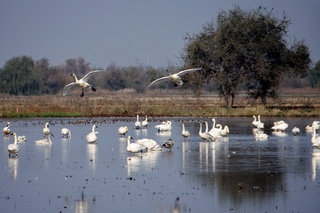 Tundra swans (Cygnus columbianus) are found in winter only in all areas of Sutter County except the Sutter Buttes and all areas below approximately 2,000 feet in Yuba County—in other words, below Bullards Bar Reservoir. They are celebrated each November in the Marysville Swan Festival. These tundra swans are shown in District Ten. Photo by queerbychoice.
Tundra swans (Cygnus columbianus) are found in winter only in all areas of Sutter County except the Sutter Buttes and all areas below approximately 2,000 feet in Yuba County—in other words, below Bullards Bar Reservoir. They are celebrated each November in the Marysville Swan Festival. These tundra swans are shown in District Ten. Photo by queerbychoice.
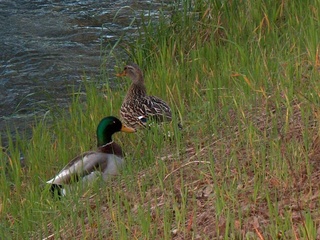 Mallard ducks (Anas platyrhynchos) are common year-round in all areas of Yuba and Sutter Counties. This male and female mallard duck are shown on the bank of the American River. Photo by queerbychoice.
Mallard ducks (Anas platyrhynchos) are common year-round in all areas of Yuba and Sutter Counties. This male and female mallard duck are shown on the bank of the American River. Photo by queerbychoice.
- wood duck: pictures | video | sound (year-round in all of Yuba and Sutter Counties per California Department of Fish and Game: California Wildlife Habitat Relationships System: Life History Accounts and Range Maps; prefers a birdhouse located ten to twenty feet off the ground with 10" x 18" floor, 10" to 24" high ceiling, and entrance hole 4" in diameter placed 12" to 16" above the floor per U.S. Fish & Wildlife Service Migratory Bird Program)
- Northern pintail: pictures | video | sound (year-round in all of Sutter County and some of western Yuba County; winter only in some other parts of Yuba County per California Department of Fish and Game: California Wildlife Habitat Relationships System: Life History Accounts and Range Maps)
- American wigeon: pictures | video | sound (year-round in most of Sutter County; winter only in the remainder of Sutter County and most of Yuba County per California Department of Fish and Game: California Wildlife Habitat Relationships System: Life History Accounts and Range Maps)
- green-winged teal: pictures | video | sound (winter only; all of Sutter County and most of Yuba County per California Department of Fish and Game: California Wildlife Habitat Relationships System: Life History Accounts and Range Maps)
- Northern shoveler: pictures | video | sound (year-round in most of Sutter County; winter only in all of Yuba County and the remainder of Sutter County per California Department of Fish and Game: California Wildlife Habitat Relationships System: Life History Accounts and Range Maps)
- cinnamon teal: pictures | video | sound (year-round; all of Sutter County and most of Yuba County per California Department of Fish and Game: California Wildlife Habitat Relationships System: Life History Accounts and Range Maps)
- mallard: pictures | video | sound (year-round in all of Yuba and Sutter Counties per California Department of Fish and Game: California Wildlife Habitat Relationships System: Life History Accounts and Range Maps; more information available from National Geographic)
- greater white-fronted goose: pictures | video | sound (winter only; all of Sutter County and some of western Yuba County per California Department of Fish and Game: California Wildlife Habitat Relationships System: Life History Accounts and Range Maps)
- redhead: pictures | video | sound (year-round; all of Sutter County and some of western Yuba County per California Department of Fish and Game: California Wildlife Habitat Relationships System: Life History Accounts and Range Maps)
- greater scaup: pictures | video | sound (winter-only; southern Sutter County and central Yuba County per California Department of Fish and Game: California Wildlife Habitat Relationships System: Life History Accounts and Range Maps)
- canvasback: pictures | video | sound (winter only; most of Yuba and Sutter Counties per California Department of Fish and Game: California Wildlife Habitat Relationships System: Life History Accounts and Range Maps)
- Canada goose: pictures | video | sound (winter only; all of Sutter County and most of Yuba County per California Department of Fish and Game: California Wildlife Habitat Relationships System: Life History Accounts and Range Maps; more information available from National Geographic)
- cackling goose: pictures | video | sound (winter only; northwestern Sutter County per California Department of Fish and Game: California Wildlife Habitat Relationships System: Life History Accounts and Range Maps)
- bufflehead: pictures | video | sound (winter only; all of Yuba and Sutter Counties per California Department of Fish and Game: California Wildlife Habitat Relationships System: Life History Accounts and Range Maps)
- snow goose: pictures | video | sound (winter only; most of Sutter County and patches of western and central Yuba County per California Department of Fish and Game: California Wildlife Habitat Relationships System: Life History Accounts and Range Maps)
- Ross's goose: pictures | video | sound (winter only; most of Sutter County and some of western Yuba County per California Department of Fish and Game: California Wildlife Habitat Relationships System: Life History Accounts and Range Maps)
- tundra swans: pictures | video | sound (winter only; most of Yuba and Sutter Counties per California Department of Fish and Game: California Wildlife Habitat Relationships System: Life History Accounts and Range Maps)
- common merganser: pictures | video | sound (year-round in most of Sutter County and some of western Yuba County; winter only in the remainder of Yuba and Sutter Counties per California Department of Fish and Game: California Wildlife Habitat Relationships System: Life History Accounts and Range Maps)
- ruddy duck: pictures | video | sound (year-round in all of Sutter County and most of Yuba County; winter only in the remainder of Yuba County per California Department of Fish and Game: California Wildlife Habitat Relationships System: Life History Accounts and Range Maps)
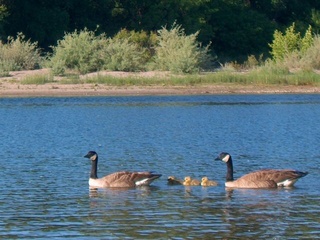 Canada geese (Branta canadensis) are found in all areas of Sutter County and all areas below approximately 2,000 feet in Yuba County—in other words, from approximately Dobbins downward. These two Canada geese are shown taking their goslings for a swim in the American River. Photo by queerbychoice.
Canada geese (Branta canadensis) are found in all areas of Sutter County and all areas below approximately 2,000 feet in Yuba County—in other words, from approximately Dobbins downward. These two Canada geese are shown taking their goslings for a swim in the American River. Photo by queerbychoice.
Hummingbird Family
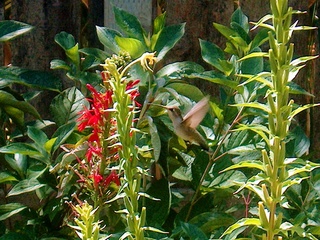 A female Anna's hummingbird (Calypte anna) sips nectar from a cardinal flower in a Marysville garden. Anna's hummingbirds are found year-round in all areas of Sutter County and all but the extreme eastern edge of Yuba County—at North Star—where they are found only in the summer. Photo by queerbychoice.
A female Anna's hummingbird (Calypte anna) sips nectar from a cardinal flower in a Marysville garden. Anna's hummingbirds are found year-round in all areas of Sutter County and all but the extreme eastern edge of Yuba County—at North Star—where they are found only in the summer. Photo by queerbychoice.
- black-chinned hummingbird: pictures | video | sound (summer only; all of Sutter County and the western half of Yuba County per California Department of Fish and Game: California Wildlife Habitat Relationships System: Life History Accounts and Range Maps; more information available from National Geographic)
- Anna's hummingbird: pictures | video | sound (year-round in all of Sutter County and most of Yuba County; summer only in the remainder of Yuba County per California Department of Fish and Game: California Wildlife Habitat Relationships System: Life History Accounts and Range Maps; prefers the nectar of manzanitas currants, sages, and California fuchsias per Las Pilitas Nursery; more information available from National Geographic)
- Calliope hummingbird: pictures | video | sound (summer only; northeastern Yuba County per California Department of Fish and Game: California Wildlife Habitat Relationships System: Life History Accounts and Range Maps)
- rufous hummingbird: pictures | video | sound (summer only; northeastern Yuba County per California Department of Fish and Game: California Wildlife Habitat Relationships System: Life History Accounts and Range Maps; more information available from National Geographic)
Kingfisher Family
- belted kingfisher: pictures | video | sound (year-round in all of Yuba and Sutter Counties per California Department of Fish and Game: California Wildlife Habitat Relationships System: Life History Accounts and Range Maps)
Nightjar Family
- common nighthawk: pictures | video | sound (summer only; eastern half of Yuba County per California Department of Fish and Game: California Wildlife Habitat Relationships System: Life History Accounts and Range Maps; more information available from National Geographic)
- common poorwill: pictures | video | sound (summer only; all of Yuba and Sutter Counties per California Department of Fish and Game: California Wildlife Habitat Relationships System: Life History Accounts and Range Maps)
New World Quail Family
- California quail: pictures | video | sound (year-round in all of Yuba and Sutter Counties per California Department of Fish and Game: California Wildlife Habitat Relationships System: Life History Accounts and Range Maps; found in central oak woodland per Las Pilitas Nursery; eats bits of lupines, sages, and elderberries per Las Pilitas Nursery; eats black oil sunflower seeds, hulled sunflower seeds, cracked corn, millet, milo, nyjer, and oats from ground and platform bird feeders per Project FeederWatch: Common Feeder Birds; more information available from National Geographic)
Owl Family
- Northern saw-whet owl: pictures | video | sound (year-round; northeastern Yuba County per California Department of Fish and Game: California Wildlife Habitat Relationships System: Life History Accounts and Range Maps)
- short-eared owl: pictures | video | sound (year-round in most of Sutter County; winter only in the remainder of Sutter County and most of Yuba County per California Department of Fish and Game: California Wildlife Habitat Relationships System: Life History Accounts and Range Maps)
- burrowing owl: pictures | video | sound (year-round in all of Sutter County and some of western Yuba County; winter only in some other parts of Yuba County per California Department of Fish and Game: California Wildlife Habitat Relationships System: Life History Accounts and Range Maps)
- great horned owl: pictures | video | sound (year-round in all of Yuba and Sutter Counties per California Department of Fish and Game: California Wildlife Habitat Relationships System: Life History Accounts and Range Maps; prefers to nest in abandoned crow or hawk nests or on a 24" x 24" platform with no walls per U.S. Fish & Wildlife Service Migratory Bird Program; more information available from National Geographic)
- Western screech owl: pictures | video | sound (year-round; all of Sutter County and most of Yuba County per California Department of Fish and Game: California Wildlife Habitat Relationships System: Life History Accounts and Range Maps; prefers to nest in abandoned woodpecker holes or in a birdhouse lined with an inch or two of wood shavings and located ten to thirty feet off the ground with 8" x 8" floor, 12" to 15" high ceiling, and entrance hole 3" in diameter placed 9" to 12" above the floor per U.S. Fish & Wildlife Service Migratory Bird Program)
Pigeon Family
- band-tailed pigeon: pictures | video | sound (year-round in northeastern Yuba County; winter only in some other parts of Yuba County per California Department of Fish and Game: California Wildlife Habitat Relationships System: Life History Accounts and Range Maps; found in central oak woodland and yellow pine forest per Las Pilitas Nursery; eats acorns, cherries, elderberries, manzanitas, toyon berries, and dogwood berries per Las Pilitas Nursery; eats black oil sunflower seeds, hulled sunflower seeds, cracked corn, millet, milo, and peanut hearts from ground, large hopper, and platform bird feeders per Project FeederWatch: Common Feeder Birds; more information available from National Geographic)
- mourning dove: pictures | video | sound (year-round in all of Sutter County and most of Yuba County; summer only in the remainder of Yuba County per California Department of Fish and Game: California Wildlife Habitat Relationships System: Life History Accounts and Range Maps; found in valley grassland per Las Pilitas Nursery; likes needlegrasses per Las Pilitas Nursery; eats black oil sunflower seeds, hulled sunflower seeds, cracked corn, millet, milo, nyjer, oats, peanut hearts, and safflower from ground, large hopper, and platform bird feeders per Project FeederWatch: Common Feeder Birds; more information available from National Geographic)
Pelican Family
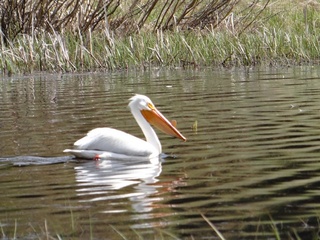 American white pelicans (Pelecanus erythrorhynchos) are found year-round in all of Sutter County and all areas below approximately 100 feet in Yuba County—in other words, from approximately the Trainer Hills downward. This American white pelican is shown in Snake Lake in Plumas County; the presence of the horn on top of its bill and the brightness of its bill color indicate that it is in breeding plumage. Photo by queerbychoice.
American white pelicans (Pelecanus erythrorhynchos) are found year-round in all of Sutter County and all areas below approximately 100 feet in Yuba County—in other words, from approximately the Trainer Hills downward. This American white pelican is shown in Snake Lake in Plumas County; the presence of the horn on top of its bill and the brightness of its bill color indicate that it is in breeding plumage. Photo by queerbychoice.
- American white pelican: pictures | video | sound (year-round; all of Sutter County and some of western Yuba County per California Department of Fish and Game: California Wildlife Habitat Relationships System: Life History Accounts and Range Maps)
Swift Family
white-throated swift: pictures | video | sound (year-round in northern Sutter County and northwestern Yuba County; summer only in the eastern half of Yuba County per California Department of Fish and Game: California Wildlife Habitat Relationships System: Life History Accounts and Range Maps)
Woodpecker Family
 Northern flickers (Colaptes auratus) are found year-round in all of Sutter County and all areas below approximately 2,000 feet in Yuba County—in other words, below Bullards Bar Reservoir—and in summer only in the remainder of Yuba County. This Northern flicker, seen in a garden in Marysville, is a male of the red-shafted race, as indicated by his red "mustache" (malar stripe). Males of the yellow-shafted race have black mustaches, while females of the red-shafted race have pale tan mustaches, and females of the yellow-shafted race have no mustaches. Photo by queerbychoice.
Northern flickers (Colaptes auratus) are found year-round in all of Sutter County and all areas below approximately 2,000 feet in Yuba County—in other words, below Bullards Bar Reservoir—and in summer only in the remainder of Yuba County. This Northern flicker, seen in a garden in Marysville, is a male of the red-shafted race, as indicated by his red "mustache" (malar stripe). Males of the yellow-shafted race have black mustaches, while females of the red-shafted race have pale tan mustaches, and females of the yellow-shafted race have no mustaches. Photo by queerbychoice.
- Northern flicker: pictures | video | sound (year-round in all of Sutter County and most of Yuba County; summer only in northeastern Yuba County per California Department of Fish and Game: California Wildlife Habitat Relationships System: Life History Accounts and Range Maps; found in central oak woodland, yellow pine forest, and riparian forest per Las Pilitas Nursery; likes oaks and conifers per Las Pilitas Nursery; eats ants and fruit per Las Pilitas Nursery; eats black oil sunflower seeds, cracked corn, hulled sunflower seeds, millet, peanut hearts, peanuts, safflower, and suet from large hopper, platform, and suet cage bird feeders per Project FeederWatch: Common Feeder Birds; prefers a birdhouse exposed to direct sunlight, with roughened interior and a 2" layer of woodchips and coarse sawdust on the floor, placed six to twenty feet off the ground with 7" x 7" floor, 16" to 18" high ceiling, and entrance hole 2.5" in diameter placed 14" to 16" above the floor per U.S. Fish & Wildlife Service Migratory Bird Program)
- pileated woodpecker: pictures | video | sound (year-round; eastern half of Yuba County per California Department of Fish and Game: California Wildlife Habitat Relationships System: Life History Accounts and Range Maps; eats black oil sunflower seeds, hulled sunflower seeds, mealworms, peanut hearts, peanuts, and suet from suet cage bird feeders per Project FeederWatch: Common Feeder Birds; prefers a birdhouse exposed to direct sunlight, with roughened interior and a 2" layer of woodchips and coarse sawdust on the floor, placed fifteen to twenty-five feet off the ground with 8" x 8" floor, 16" to 24" high ceiling, and entrance hole 3" x 4" placed 12" to 20" above the floor per U.S. Fish & Wildlife Service Migratory Bird Program; more information available from National Geographic)
- white-headed woodpecker: pictures | video | sound (year-round; northeastern Yuba County per California Department of Fish and Game: California Wildlife Habitat Relationships System: Life History Accounts and Range Maps)
- hairy woodpecker: pictures | video | sound (winter only in central Yuba County; year-round in northeastern Yuba County per California Department of Fish and Game: California Wildlife Habitat Relationships System: Life History Accounts and Range Maps; eats black oil sunflower seeds, hulled sunflower seeds, mealworms, peanut hearts, peanuts, safflower, and suet from large hopper, platform, and suet cage bird feeders per Project FeederWatch: Common Feeder Birds; prefers a birdhouse exposed to direct sunlight, with roughened interior and a 2" layer of woodchips and coarse sawdust on the floor, placed eight to twenty feet off the ground with 6" x 6" floor, 12" to 15" high ceiling, and entrance hole 1.5" in diameter placed 9" to 12" above the floor per U.S. Fish & Wildlife Service Migratory Bird Program; more information available from National Geographic)
- acorn woodpecker: pictures | video | sound (year-round; all of Sutter County and most of Yuba County per California Department of Fish and Game: California Wildlife Habitat Relationships System: Life History Accounts and Range Maps; found in central oak woodland, yellow pine forest, and riparian forest per Las Pilitas Nursery; likes Frémont's cottonwood, Western sycamore, alders, willows, and oaks per Las Pilitas Nursery; more information available from National Geographic)
- Lewis's woodpecker: pictures | video | sound (winter only; all of Yuba and Sutter Counties per California Department of Fish and Game: California Wildlife Habitat Relationships System: Life History Accounts and Range Maps; prefers a birdhouse exposed to direct sunlight, with roughened interior and a 2" layer of woodchips and coarse sawdust on the floor, placed twelve to twenty feet off the ground with 7" x 7" floor, 16" to 18" high ceiling, and entrance hole 2.5" in diameter placed 14" to 16" above the floor per U.S. Fish & Wildlife Service Migratory Bird Program)
- black-backed woodpecker: pictures | video | sound (winter only; northeastern Yuba County per California Department of Fish and Game: California Wildlife Habitat Relationships System: Life History Accounts and Range Maps)
- Nuttall's woodpecker: pictures | video | sound (year-round; all of Sutter County and the western half of Yuba County per California Department of Fish and Game: California Wildlife Habitat Relationships System: Life History Accounts and Range Maps; found in central oak woodland and riparian forest per Las Pilitas Nursery; likes oaks and pines per Las Pilitas Nursery; more information available from National Geographic)
- downy woodpecker: pictures | video | sound (year-round; all of Yuba and Sutter Counties per California Department of Fish and Game: California Wildlife Habitat Relationships System: Life History Accounts and Range Maps; found in central oak woodland, yellow pine forest and riparian forest per Las Pilitas Nursery; eats ants, beetles, and fruit per Las Pilitas Nursery; eats black oil sunflower seeds, hulled sunflower seeds, mealworms, peanut hearts, peanuts, safflower, and suet from large and small hopper, platform, and suet cage bird feeders per Project FeederWatch: Common Feeder Birds; prefers a birdhouse exposed to direct sunlight, with roughened interior and a 2" layer of woodchips and coarse sawdust on the floor, placed five to fifteen feet off the ground with 4" x 4" floor, 8" to 10" high ceiling, and entrance hole 1.25" in diameter placed 6" to 8" above the floor per U.S. Fish & Wildlife Service Migratory Bird Program; more information available from National Geographic)
- red-breasted sapsucker: pictures | video | sound (winter only in all of Sutter County and the western half of Yuba County; summer only in far northeastern Yuba County; year-round in the remainder of Yuba County per California Department of Fish and Game: California Wildlife Habitat Relationships System: Life History Accounts and Range Maps; found in central oak woodland, yellow pine forest and riparian forest per Las Pilitas Nursery; likes willows per Las Pilitas Nursery; more information available from National Geographic)
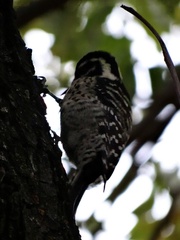 Nuttall's woodpeckers (Picoides nuttallii) are found year-round in all of Sutter County and all areas below approximately 2,000 feet in Yuba County—in other words, below Bullards Bar Reservoir. This Nuttall's woodpecker, seen in a garden in Marysville, is female; a male would have a red spot on the top of his head. Photo by queerbychoice.
Nuttall's woodpeckers (Picoides nuttallii) are found year-round in all of Sutter County and all areas below approximately 2,000 feet in Yuba County—in other words, below Bullards Bar Reservoir. This Nuttall's woodpecker, seen in a garden in Marysville, is female; a male would have a red spot on the top of his head. Photo by queerbychoice.
Cormorant Family
- double-crested cormorant: pictures | video | sound (winter only; all of Sutter County and most of Yuba County per California Department of Fish and Game: California Wildlife Habitat Relationships System: Life History Accounts and Range Maps)
Links
Las Pilitas Nursery: California Native Birds
Project FeederWatch: Common Feeder Birds
U.S. Fish & Wildlife Service Migratory Bird Program
Footnotes
1. U.S. Fish and Wildlife Service: Butte Sink Wildlife Management Area
2. Ducks Unlimited: Butte Basin NAWCA II: Butte Sink NWR Enhancement


